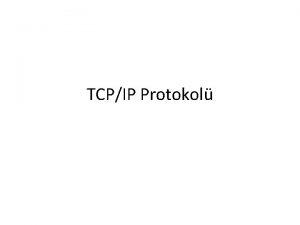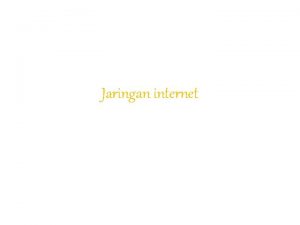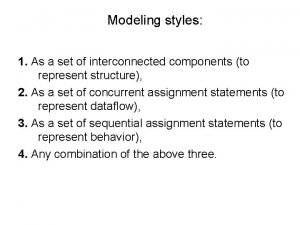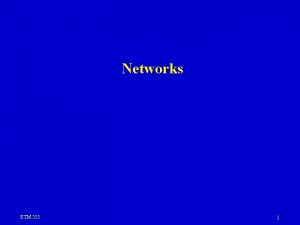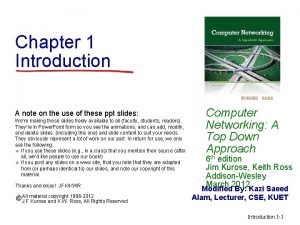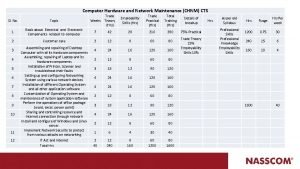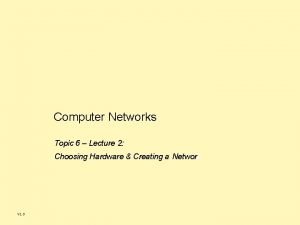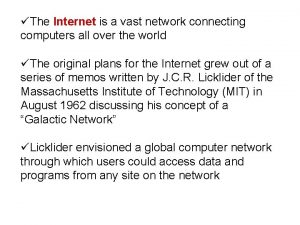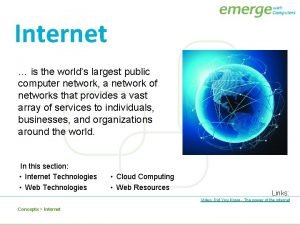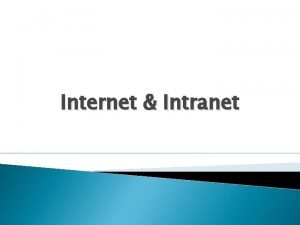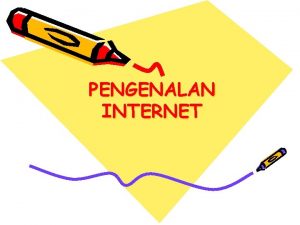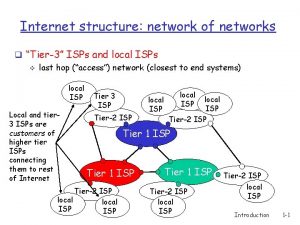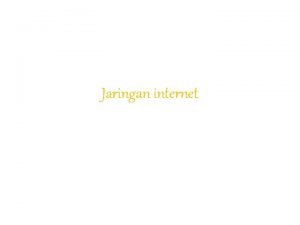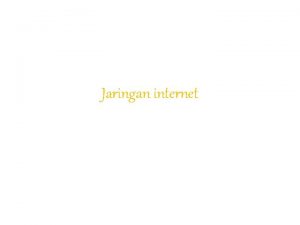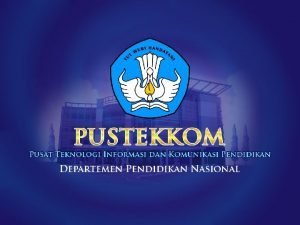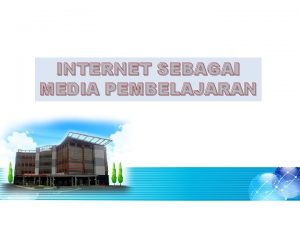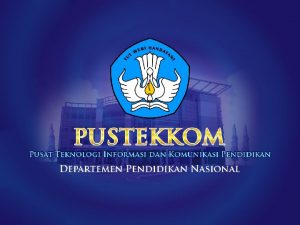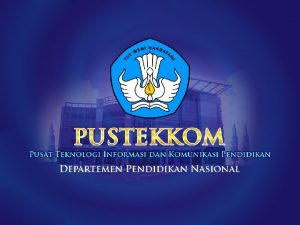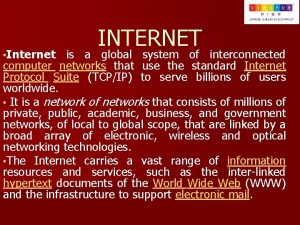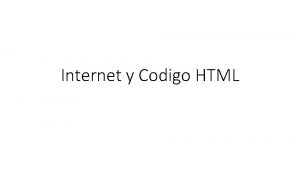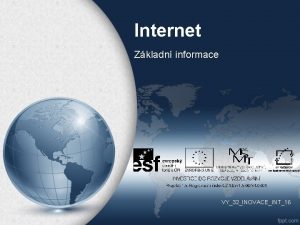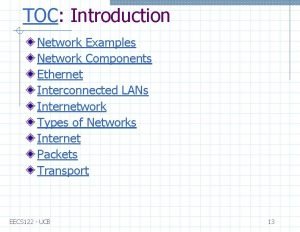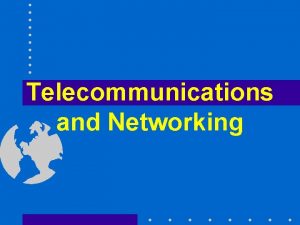Hardware Internet is a network of interconnected Host





















- Slides: 21

Hardware – Internet is a network of interconnected Host Computers or Hosts – Each host is assigned a unique IP address, e. g. 146. 245. 1. 13 IP Stands for Internet Protocol

Computers Communicate Through PACKETS Analogy to letters sent by regular mail Contain: – – • A source address A destination address Sequencing Information Error Control Information Source is IP address of computer sending Destination is IP address of destination computer Data sent across internet is usually divided into multiple packets Packets may arrive at destination out of order

Internet is a Complex Network of Computers Router, a special kind of host, ensures that packets reach their destination.

Communication • Server is a host on the Internet that manages network resources and fulfills requests from clients. • Many types of servers: Web servers, e-mail servers Database servers and file servers; single server may provide multiple services. • Web server stores web pages and delivers them to clients upon request Web browser uses the hypertext transfer protocol (HTTP) to request and Transfer pages from a Web server.

Common Protocols FTP POP File Transfer Protocol Post Office Protocol (for sending email) SMTP Simple Mail Transfer Protocol (for receiving email)

Communication Media Bits, Bytes, Kilobytes, Megabytes, Gigabyte, Terabytes MICRO-MINIATURIZATION; MOORE’s LAW ASCII – American Standard Code for International Intechange 256 What is so special about this number? ? And 1024? ?

Communications Media / Cont. Bandwidth: how much data can be transferred through a medium in fixed amount of time? bps = Bits per second; MHZ = Mega Hertz = 1000’s cycles per second Kbps; Mbps, Gbps, Tbps; Copper wire used for POTS (Plain old telephone system) Advantages: available, reliable, ease of installation Disadvantage: Speed

Communication Media/ Cont. Hence Fiber Optic Cable: flexible glass fiber; thinner and lighter; Yet with much wider bandwidth; Uses bursts of light to represent bits, rather than electronic bits interpreted by computers as bits. Optical Modem (modem stands for modulator – demodulator) translates digital signals from computers into light through a process called modulation

Fiber Optic Cable/ Cont. • Light is transmitted over the fiberoptic cable to the receiver’s optical modem • Converts the light back into electrical signals through a process called demodulation

Recent New Optical Technology Called Opto -Chip • Able to convert most basic particle of light, PHOTON into electric current. • Process allows tremendous amounts of data to be sent over fiber-optic networks through particles 100 times smaller than the diameter of a human hair.

Opto-Chip/ Cont. • Further enhancements allow multiple wavelengths to be transmitted over a single fiber. • Repeaters amplify signals, thereby countering deterioration of signals over distance over copper and fiber-optic networks. • Fiber optic networks are also more complicated and expensive to develop and maintain. Must be carefully cut and polished.

Storage Area Network (SAN) Provides high capacity, Reliable data storage on a network; Fault Tolerant. • • • Stores multiple terabytes. High speed fiber-optic line Data collected in logical groups Large volume storage, may provide Backup and recovery Redundant copies stored using “mirror” technology” – SAN uses fiber-channel technology – Operates at transfer rates of 100 Mbps

Most Home Users Use ISP (internet service providers) (SEE TABLE) • Modem is employed Takes DIGITAL SIGNAL (Computer) – Converts into ANALOG SIGNAL (Modem into telephone line) Converted back into DIGITAL SIGNAL (Line into Modem and Recipient Computer)

Digital Subscriber Line (DSL) • Offers high bandwidth over standard copper telephone lines • x. DSL refers to many forms • ADSL means assymmetric – Slower Upstream (Sending) than Downstream (Receiving) • SDSL means symmetric – Same upstream and downstream – Up to 3 Mbps.

DSL / cont. • HDSL high speed DSL – Also same upstream and downstream – Rates up to 1, 544 Mbps – Users within 4500 feet of a central office – offers rates 13 Mbps to 55 Mbps • VDSL very high speed DSL.

More DSL • Transformns copper Telephone Wire into High Speed Digital Connection • Does not require any additional rewiring • Exploits existing wiring; • Takes advantage of bandwidths unused • Gives 3 information carrying lines: – 1 internet to home computer – 1 transports from home to internet – 1 for regular phone and faxes.

• Still More DSL • Much faster speeds than Modem over Telephone • Requires Hardware at the local telephone company’s central office • Speed decreases over distance • Fastest DSL is within a few thousand feet of central office. • Voice Over DSL (Vo. DSL) takes advantage of high bandwidth of DSL – voice services over single line

Broadband • Category of high bandwidth Internet Service provided mainly by Cable TV and Telephone Companies to home users. • Can handle Voice, Data and Video • Enables Video-Conferencing, Real. Time Voice and Streaming-Media Applications. • Eliminates need to dial in to an ISP

CABLE MODEM • Perhaps most popular form of more advanced service being adopted by the public. • Transmission over same cable that brings Television to home/business. • UNLIKE DSL, bandwidth is shared with many users. • Can reduce bandwidth available to many people in one building or neighborhood. • Can typically offer downstream rate between 384 Kbps and 1. 5 Mbps and upstream of 128 Kbps. • Elimnates need for extra phone line for computer in home

Integrated Services Digital Network • Provides High-speed connections to the Internet over both digital and standard telephone lines. • Transfer speeds up to 128 Kbps. • Uses Hardware called terminal adaptor (TA) and ISP that provides ISDN. • Limited availability and Expensive. • Uses 3 Channels – Basic Rate Interface (BRI) – Two Bearer (B) Channels supporting data transfers at 64 Kbps. – Data Channel (D) is used to transmit Routing Information. – Each B Channel may be used for Voice or Data Communication and Combined for Maximum (128 Kbps) rate.

T-1 and T-3 Lines • T-1 is a dedicated connection that supports data rates of 1. 544 Mbps. • Made up of 24 channels – Each channel supports 64 Kbps • T-3 Line Supports data rates of 43 Mbps and is made up of 672 channels that each support 64 Kbps. • T-1 and T-3 can be used for both voice and data communication. – Like a “hub” – used for large organizations
 Definitive host vs intermediate host
Definitive host vs intermediate host Interconnected networks internet
Interconnected networks internet Interconnected network adalah
Interconnected network adalah Internal and external components of computer
Internal and external components of computer The interconnected economies of the nations of the world
The interconnected economies of the nations of the world Interconnected systems framework
Interconnected systems framework Set of interconnected components
Set of interconnected components Too interconnected to fail
Too interconnected to fail Show that the maximum efficiency of pure aloha is 1/(2e)
Show that the maximum efficiency of pure aloha is 1/(2e) Interconnected computer networks that
Interconnected computer networks that They relay packets among multiple interconnected networks
They relay packets among multiple interconnected networks Hardware software
Hardware software Computer hardware & network maintenance
Computer hardware & network maintenance Peer to peer network hardware
Peer to peer network hardware Basic network hardware
Basic network hardware What is internet
What is internet Vast network
Vast network Internet is the largest
Internet is the largest Intranet advantages and disadvantages
Intranet advantages and disadvantages Internet international network
Internet international network International networking adalah
International networking adalah Internet structure network of networks
Internet structure network of networks

